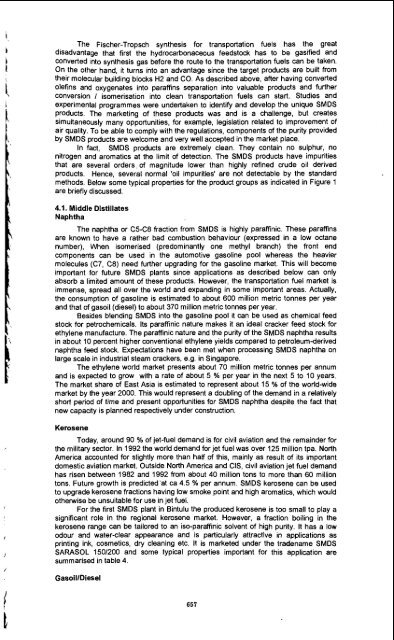SHELL MIDDLE DISTILLATE SYNTHESIS: FISCHER-TROPSCH ...
SHELL MIDDLE DISTILLATE SYNTHESIS: FISCHER-TROPSCH ...
SHELL MIDDLE DISTILLATE SYNTHESIS: FISCHER-TROPSCH ...
Create successful ePaper yourself
Turn your PDF publications into a flip-book with our unique Google optimized e-Paper software.
',<br />
L<br />
I<br />
The Fischer-Tropsch synthesis for transportation fuels has the great<br />
disadvantage that first the hydrocarbonaceous feedstock has to be gasified and<br />
converted into synthesis gas before the route to the transportation fuels can be taken.<br />
On the other hand, it turns into an advantage since the target products are built from<br />
their molecular building blocks H2 and CO. As described above, after having converted<br />
olefins and oxygenates into paraffins separation into valuable products and further<br />
conversion I isomerisation into clean transportation fuels can start. Studies and<br />
experimental programmes were undertaken to identify and develop the unique SMDS<br />
products. The marketing of these products was and is a challenge, but creates<br />
simultaneously many opportunities, for example, legislation related to improvement of<br />
air quality. To be able to comply with the regulations, components of the purity provided<br />
by SMDS products are welcome and very well accepted in the market place.<br />
In fact,<br />
SMDS products are extremely clean. They contain no sulphur, no<br />
nitrogen and aromatics at the limit of detection. The SMDS products have impurities<br />
that are several orders of magnitude lower than highly refined crude oil derived<br />
products. Hence, several normal 'oil impurities' are not detectable by the standard<br />
methods. Below some typical properties for the product groups as indicated in Figure 1<br />
are briefly discussed.<br />
4.1. Middle Distillates<br />
Naphtha<br />
The naphtha or C5-C8 fraction from SMDS is highly paraffinic. These paraffins<br />
are known to have a rather bad combustion behaviour (expressed in a low octane<br />
number), Wen isomerised (predominantly one methyl branch) the front end<br />
components can be used in the automotive gasoline pool whereas the heavier<br />
molecules (C7, C8) need further upgrading for the gasoline market. This will become<br />
important for future SMDS plants since applications as described below can only<br />
absorb a limited amount of these products. However, the transportation fuel market is<br />
immense, spread all over the world and expanding in some important areas. Actually,<br />
the consumption of gasoline is estimated to about 600 million metric tonnes per year<br />
and that of gasoil (diesel) to about 370 million metric tonnes per year.<br />
Besides blending SMDS into the gasoline pool it can be used as chemical feed<br />
stock for petrochemicals. Its paraffinic nature makes it an ideal cracker feed stock for<br />
ethylene manufacture. The paraffinic nature and the purity of the SMDS naphtha results<br />
in about 10 percent higher conventional ethylene yields compared to petroleum-derived<br />
naphtha feed stock. Expectations have been met when processing SMDS naphtha on<br />
large scale in industrial steam crackers, e.g. in Singapore.<br />
The ethylene world market presents about 70 million metric tonnes per annum<br />
and is expected to grow with a rate of about 5 % per year in the next 5 to 10 years.<br />
The market share of East Asia is estimated to represent about 15 % of the world-wide<br />
market by the year 2000. This would represent a doubling of the demand in a relatively<br />
short period of time and present opportunities for SMDS naphtha despite the fact that<br />
new capacity is planned respectively under construction.<br />
Kerosene<br />
Today, around 90 % of jet-fuel demand is for civil aviation and the remainder for<br />
the military sector. In 1992 the world demand for jet fuel was over 125 million tpa. North<br />
America accounted for slightly more than half of this, mainly as result of its important<br />
domestic aviation market. Outside North America and CIS, civil aviation jet fuel demand<br />
has risen between 1982 and 1992 from about 40 million tons to more than 60 million<br />
tons. Future growth is predicted'at ca 4.5 % per annum. SMDS kerosene can be used<br />
to upgrade kerosene fractions having low smoke point and high aromatics, which would<br />
otherwise be unsuitable for use in jet fuel.<br />
For the first SMDS plant in Bintulu the produced kerosene is too small to play a<br />
significant role in the regional kerosene market. However, a fraction boiling in the<br />
kerosene range can be tailored to an iso-paraffinic solvent of high purity. It has a low<br />
odour and water-clear appearance and is particularly attractive in applications as<br />
printing ink, cosmetics, dry cleaning etc. It is marketed under the tradename SMDS<br />
SARASOL 150/200 and some typical properties important for this application are<br />
summarised in table 4.<br />
GasoillDiesel<br />
657

















